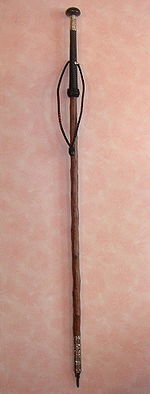- Makila
-
A Makila, with a horn pommel, woven leather grip and nickel silver fittings

The makila (sometimes spelled makhila) is a traditional Basque walking stick, and is notable as both a practical tool and a cultural symbol of authority and strength.
Contents
Etymology
“Makila” in Euskara (Basque language) literally can mean “stick,” “walking cane,” “rod,” “club,” or “mace.” The word is derived from the Latin bacillum ("little staff"). "Makila" itself carries certain connotations, for instance in the verb form, makilatu, meaning “to bludgeon,” or the derived makila-ukaldi, meaning “club-strike” or “mace-strike.” The term outside of Basque country has come to be associated with the unique walking stick carried by Basques.
Appearance
The makila walking stick consists of an engraved medlar wood shaft cut to a length to suit its owner, generally either hipbone or sternum-height (1-1.4 meters). The bottom is often shod with steel or other metal and ends in a ferrule (blunt spike for traction). The handle is also often covered with metal or woven leather to form a hand-grip, with a lanyard attached to the bottom of this grip. The stick is capped with a flattened knob or pommel, made of horn, steel, or bronze. The top portion consisting of the knob and hand-grip can be pulled off the top of the stick, revealing a hidden spike or blade, which effectively turns the stick into a short spear.
Some makila are created for ceremonial purposes, often presented as gifts or awards to individuals. They are decorated with elaborate engravings and their metal parts are made of silver or gold. These are often 1.2 m (4 ft) long rather than a custom length.
History and Crafting
The design of the makila is centuries old, and remains largely unchanged. There is little information known on its exact origin, but it may possibly be related to medieval times, as a concealable derivative of a particular form of lance or hunting spear.
The manufacturing process is as rooted in tradition as the finished product, and can take years to complete. It begins in spring, with the craftsman selecting a suitable branch from a medlar tree and carving a design into the living wood while it is still attached. The branch is left alone until late fall, during which the wood heals and expands the design on its surface. The craftsman must then return to where he found the tree and cut the branch down. The bark is then stripped off and the shaft is straightened out using careful heating in a kiln. After this, the stick must be dried by being stored for several years. Once this has happened, the wood is stained using a secret method, and then fitted with the various metal bands and fittings. The craftsman will sign his work with his family symbol or name, and also will engrave the handle or pommel with the recipients name, family crest or other text as requested.
Usage
The makila is a practical walking stick and a weapon for self-defense. They were (and still are) carried by shepherds to help guide their flocks as well as defend against wolves and other wild predators. They are carried by hunters and hikers in the Basque country as walking aids, and they are used in traditional folk dances.
The makila can be swung by the handle for fast, light strikes or used the opposite way to strike with the pommel as an effective bludgeon. The concealed spike can be used to deadly effect either as a thrusting weapon, or thrown as a last resort.
External links
- http://www.makilasalberdi.com/historia_en.htm
- http://www.makhila.com/pub-anglais/makhila/index.htm
- http://www.tourisme-pays-basque.fr/culture-traditions/makhila.htm
See also
Categories:- Hiking equipment
- Pole weapons
- Stick fighting
- Basque culture
Wikimedia Foundation. 2010.



